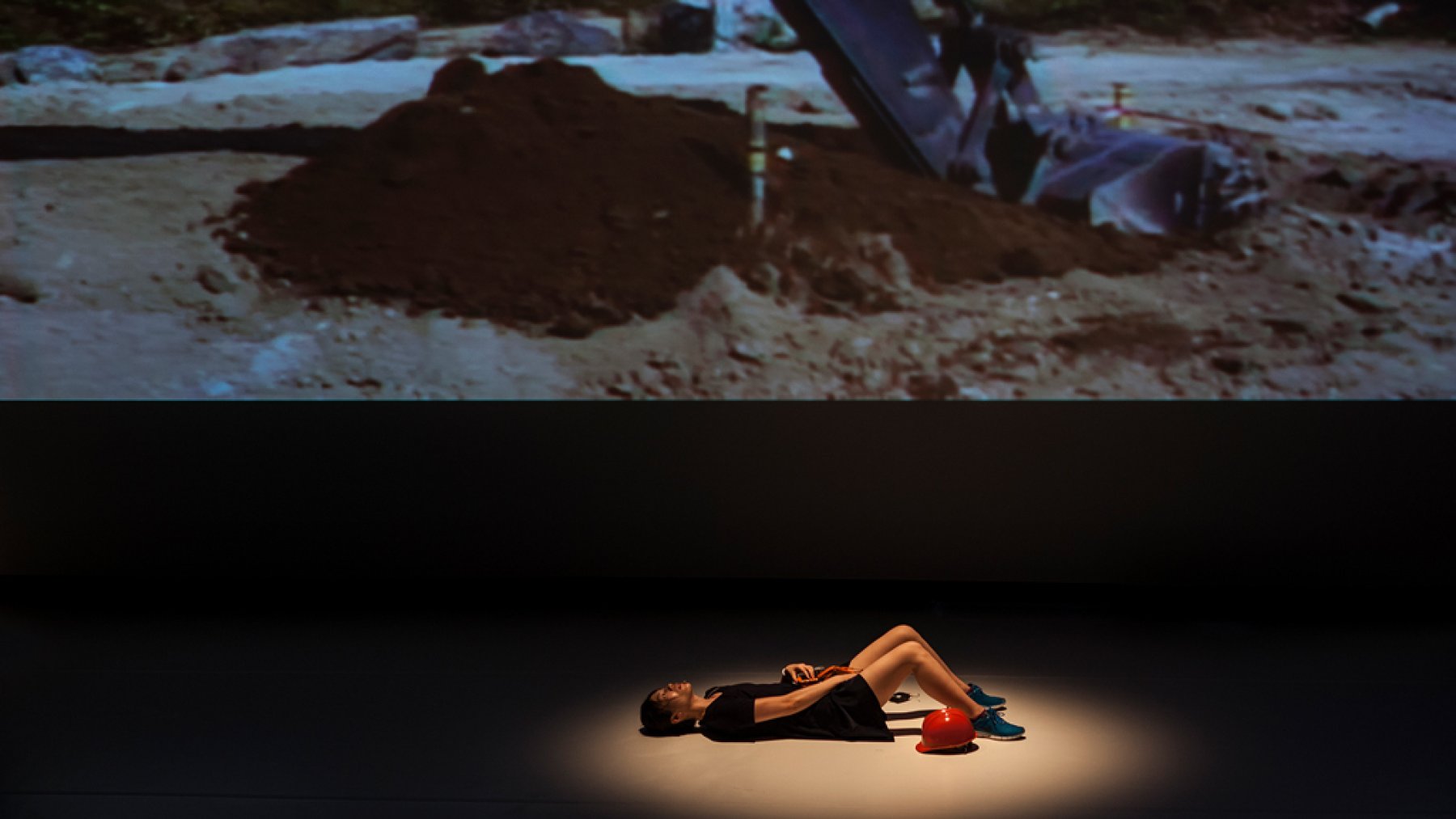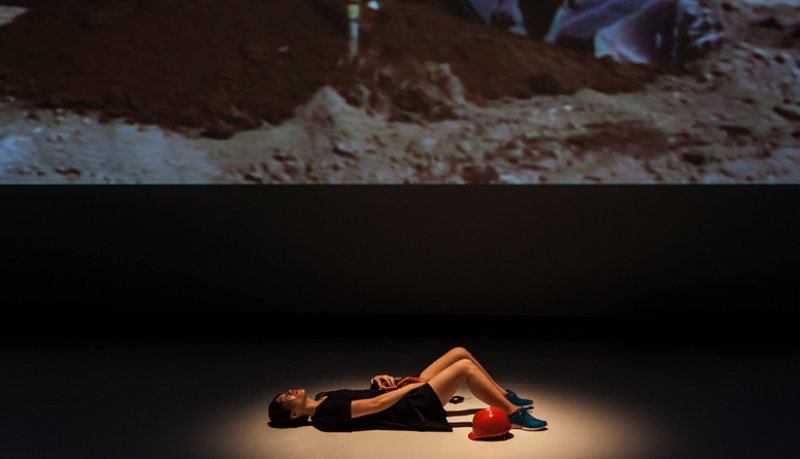The Mirror
EditorialAboutA+a Study CentreA+a ArchiveShopClose Menu

It is tempting to read the work of Geumhyung Jeong in terms of the classically humanist questions it raises about technology: Is it possible for artificial intelligence to achieve sentience? Are robots capable of love, intimacy or care? Do humans truly have mastery over the tools of their invention? These questions conceive of a human as a clearly bounded, conscious and purposeful actor with exceptional capabilities. They stem from the assumption that nature and culture, subject and object, occupy discrete, identifiable categories. Jeong’s practice, however, navigates a speculative zone prior to these human-centred ethical issues. In her performances with everyday objects and self-built automata, she is concerned with how these norms have been formed. Primarily, she works with the subject-object dyad, progressively testing its outer limits—if, in fact, there are any—from which we might extrapolate consequences that tell us something about our sociotechnological present.
Even though Jeong is chiefly engaged with human-technological interactions on a metaphysical level, her work cannot exist outside of politics. In her performed interactions, who or what appears to be active or passive, which actor possesses power, brings forth the political. Issues like the rise in digital sex crimes in South Korea,1 or the recent rejection by its Justice Department to revise the legal definition of rape to include nonconsensual sex, for example, affect how power struggles in Jeong’s work is interpreted. Human-made categories are applied to her performances, transforming the artist into victim, aggressor, carer, lover or saviour. Notably too, her native country is recognised for its embrace of technological expansion, having one of the most advanced digital economies in the world; South Korea alone is home to around 400 AI startups.2 Whether implicitly or explicitly expressed, Jeong’s practice emerges out of, and can be read against, these contextual realities.
...Jeong comes to contemporary art from an unusual background in puppetry, animation, acting and dance. As such, her approach to subject-object relations is expansive, shaped by the particular attitudes of these disciplines. She has amassed an extensive personal collection of things—mannequins, prosthetics, sex toys, domestic gadgets, beauty tools and fitness equipment—with which she physically interacts. She classifies these objects as either 'performed' or 'unperformed', depending on whether they have yet featured in her work. In 7ways (2008), for instance, she used the suction of an industrial vacuum cleaner to affix the mouth of a grey-haired mask to her flesh in a performative ‘duet’. The act was reversed in CPR Practice (2013), where she tried to breathe life into an unresponsive dummy. Spa & Beauty (2017) saw Jeong demonstrate atypical uses of beauty products and tools to make their intended functions strange. More recently, the artist has engineered her own machines—hybrid forms assembled from DC motors, aluminium profiles, joysticks and medical mannequin parts—that bridge the distance between subject and object that remained in her preceding work. Jeong is herself conscious of this move:
I didn’t plan it this way from the beginning, but it feels like there is a story that continues from my earliest to my most recent works, between real bodies/fake bodies/objects/machines/devices. The story is of a person who repeatedly tried to be friends with many different things, from household devices to mannequins, buying more advanced and expensive ones. Then, finally and slowly, she started to construct a machine in the form of a body by herself. This progression, in a way, also seems to follow the advancement of our current hyper technoculture; year after year, distinctions between the human and the technological other are getting ever more thin…3
How might we understand Jeong’s practice if not through a humanist framework? Over the past three decades, new materialism or the ‘turn to matter’ has attempted to carry out this work. In broad terms, the movement rejects anthropocentrism and nature-culture dualism, attending to the vitality and liveness of non- or more-than- human actors. It provides a different language to talk about interactions between and among things. Donna Haraway gave us her genderless fusion of animal and machine in the cyborg;4 Gilles Deleuze and Felix Guattari,5 Manuel DeLanda,6 Bruno Latour7 and Michel Callon8 their conceptions of messy togetherness in assemblage theory; and Karen Barad a radical approach to causality in ‘agential realism’.9 These theorists comprehend the world in a constant state of flux, recognise multiplicity and contingency and assign agency to forms of being (organic and inorganic) previously understood as inert or subordinate to humans. Such orientations are only becoming more relevant as the fields of artificial intelligence and the biological sciences increasingly intertwine.
And what does it look like when we apply this thinking to Jeong’s work? This is the task I set myself attending the artist’s lecture-performance, Oil Pressure Vibrator (2008), programmed as part of this year’s RISING Festival, Melbourne.10 Presented at the Australian Centre for the Moving Image (ACMI), the audience filed into the theatre while Jeong sat silent at her laptop, sternly surveying the assembling crowd. The staging was simple, arranged as one would expect of a lecture, save for a hardhat placed benignly atop the artist’s desk, under which a small toy excavator was hidden. Oil Pressure Vibrator plays out as a kind of narrativised tracing of Jeong’s practice, framing her performance history as a series of misguided attempts at locating the ideal sexual partner. Jeong, or more accurately, her fictionalised persona, takes us through a chain of romantic companions—mechanical devices and commonplace objects—via snippets from her previous performances played onscreen. Throughout, Jeong’s affect is flat and expressionless, lending a wry irony to the retelling. We realise we shouldn’t take the artist’s quest all too seriously; Jeong is distancing herself from levying any humanistic gravity upon the story.

None of the partners fully satiate her desire, and she laments the decreasing intensity of her orgasms, receiving an awkward chuckle from the audience. At one point, she falters, ‘cheating’ on her machines with a flesh-and-bone man. When a peer criticises her passivity in these affairs, Jeong arrives at the realisation that she must ‘divide herself in two’, becoming a ‘hermaphrodite’ to reach her own sexual independence. She needs to occupy both active and passive, giver and receiver, within herself. It is at this juncture that she chances upon a hydraulic excavator at a construction site. She marvels at its impressive strength and virility as it penetrates the earth. It possesses the ‘long neck and flexible joints’ she most favours in a romantic partner. Its sharply pointed breaker attachment is especially arousing. Jeong’s character is captivated, too, by its mechanical functioning, specifically the circulatory oil pressure system animating the excavator. To get closer to it, she embarks on a rigorous training course to obtain an operating license.
The lecture-performance culminates in a ceremonial act of sexual gratification that takes place on a beach. At the water’s edge, Jeong, expertly manoeuvring the machine, approaches a sand sculpture version of herself in the throes of pleasure. Gradually, she brings the robotic arm down upon the form, destroying the bodily integrity of her stand-in. Simultaneously, the ‘real’ Jeong lies on stage, stroking herself tenderly with the miniature excavator. In this strange masturbatory rite, she has achieved her objective of autoerotic satisfaction.
Oil Pressure Vibrator seeks to move beyond binary concepts, to embrace continuity with our technologised world, even in the most intimate realms of our lives. The artist does so, however, using the humanist’s tools. Division is still uncomfortably present in Jeong’s work. Throughout the performance, her efforts at sexual freedom remain bound by oppositional concepts. She flits between dichotomised roles: subject-object, phallus and vessel, dominant and submissive, without managing to collapse these distinctions. The final ritual, too, sees Jeong’s persona doubled, proxied, rather than entwined with the machinic. This is not a criticism per se, but an acknowledgment of the challenges faced in heeding the call of the new materialists. Undoing inherited assumptions is no easy task. Works like Oil Pressure Vibrator are a kind of stepping stone en route to grasping the uninterrupted flow between the human and more-than-human. We should remember that Oil Pressure Vibrator was first staged in 2008; eons ago in terms of recent advancements in AI and biotechnology. If artists are to keep step, they will need to overcome divisive thinking and welcome flux, multiplicity and interconnectedness.
1. There has been significant media coverage of South Korea’s ‘spycam epidemic’, in which tiny cameras are embedded in everyday objects like clocks, paintings, clothes hooks, and hidden in public spaces for the purposes of recording (overwhelmingly) women and girls. The footage is disseminated and paid for by men online. See ‘“My Life is Not Your Porn”: Digital Sex Crimes in South Korea’ Human Rights Watch, 15 June 2021, https://www.hrw.org/report/2021/06/16/my-life-not-your-porn/digital-sex-crimes-south-korea
2. ‘South Korea Country Commercial Guide’, International Trade Administration, 2 August 2022, https://www.trade.gov/country-commercial-guides/south-korea-information-and-communication-technology
3. Jeong qtd. in ‘Geumhyung Jeong, Real Bodies Fake Bodies’, L’officiel Art, July 2019.
4. See Donna Haraway, ‘A Manifesto for Cyborgs: Science, Technology, and Socialist Feminism in the 1980s’, Socialist Review, no. 80 (1985): pp. 65–108.
5. See Gilles Deleuze and Felix Guattari, A Thousand Plateaus: Capitalism and Schizophrenia, University of Minnesota Press, Minneapolis, 1987.
6. See Manuel De Landa, A New Philosophy of Society: Assemblage Theory and Social Complexity, Continuum, London, 2006.
7. See Bruno Latour, Reassembling the Social: An Introduction to Actor-Network-Theory, Oxford University Press, Oxford, 2005.
8. See Michel Callon, ‘Some Elements of a Sociology of Translation: Domestication of the Scallops and the Fishermen of St Brieuc Bay’, The Sociological Review, no. 32, May 1984, pp. 196–233.
9. See Karen Barad, Meeting the Universe Halfway: Quantum Physics and the Entanglement of Matter and Meaning, Duke University Press, Durham, 2007.
10. Jeong also presented the installation Under Maintenance (2021) at Arts House as part of RISING Festival.
Author/s: Stephanie Berlangieri
Stephanie Berlangieri. 2023. “Geumhyung Jeong's Oil Pressure Vibrator: Towards Human And More-than-human Continuity .” Art and Australia 58, no.2 https://artandaustralia.com/58_2/p161/geumhyung-jeongs-oil-pressure-vibrator
Art + Australia Editor-in-Chief: Su Baker Contact: info@artandaustralia.com Receive news from Art + Australia Art + Australia was established in 1963 by Sam Ure-Smith and in 2015 was donated to the Victorian College of the Arts at the University of Melbourne by then publisher and editor Eleonora Triguboff as a gift of the ARTAND Foundation. Art + Australia acknowledges the generous support of the Dr Harold Schenberg Bequest and the Centre of Visual Art, University of Melbourne. @Copyright 2022 Victorian College of the Arts The views expressed in Art + Australia are those of the contributing authors and not necessarily those of the editors or publisher. Art + Australia respects your privacy. Read our Privacy Statement. Art + Australia acknowledges that we live and work on the unceded lands of the people of the Kulin nations who have been and remain traditional owners of this land for tens of thousands of years, and acknowledge and pay our respects to their Elders past, present, and emerging. Art + Australia ISSN 1837-2422
Publisher: Victorian College of the Arts
University of Melbourne
Editor at Large: Edward Colless
Managing Editor: Jeremy Eaton
Art + Australia Study Centre Editor: Suzie Fraser
Digital Archive Researcher: Chloe Ho
Business adviser: Debra Allanson
Design Editors: Karen Ann Donnachie and Andy Simionato (Design adviser. John Warwicker)
University of Melbourne ALL RIGHTS RESERVED
